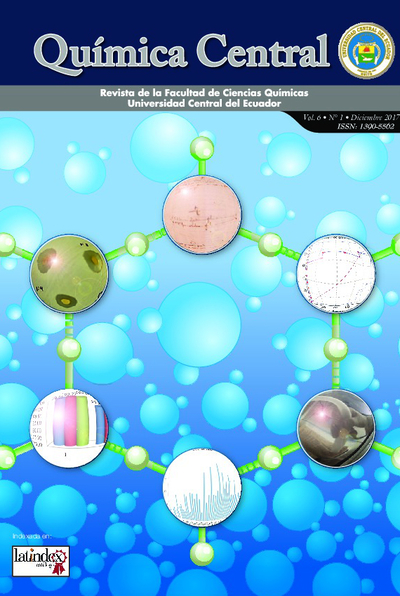Evaluation of the antibacterial activity of microalgae extracts using ATCC strains
DOI:
https://doi.org/10.29166/quimica.v6i1.1416Keywords:
microalgae´s extracts, Kirby Bauer method, zones of inhibition, antibacterial activityAbstract
The presence of multiresistant bacteria is a public health problem worldwide which generates the need to search
therapeutic alternatives of natural origin. The objective of this research was to evaluate the antibacterial activity
of ethanolic, methanolic and hexane extracts of microalgae gender: Chlorella sp., Anabaena sp., Oscillatoria
sp. and Stichococcus sp., collected at the Ecuadorian Antarctic Station Pedro Vicente Maldonado. The extracts
were obtained by the Soxhlet extraction technique. The antibacterial activity was first evaluated with the agar dilution
method, and it was identified that from the 12 extracts evaluated, the methanolic extracts of the microalgae
Oscillatoria sp. and Stichococcus sp. presented inhibitory activity against the bacterial strain Staphylococcus aureus
ATCC 25923, whereas no extract presented activity against Escherichia coli ATCC 25922. With the methanolic
extracts of Oscillatoria sp. and Stichococcus sp. the Kirby Bauer method was developed, obtaining zones
of inhibition that shows greater antibacterial activity by the Oscillatoria sp. extract. When comparing the activity
of the microalgae extracts with the broad spectrum antibiotics trimethoprim sulfamethoxazole and ciprofloxacin,
the conclusion is that these pharmaceutical products cause greater sensitivity. Through phytochemical screening
terpenoids, phenols and alkaloids were identified which could be responsible for antibacterial activityl activity.
Downloads
References
Malbrán, C. G. (2015). Resistencia a los antimicrobianos: causas, consecuencias y perspectivas en Argentina. Argentina: Dpto. Bacteriología
del Instituto Nacional de Enfermedades Infecciosas (INEI). Recuperado de: http://186.33.221.24/medicamentos//files/Resistencia_antimicrobiana_en_Argentina.pdf
OMS. (2016). Resistencia a los antimicrobianos. Recuperado el 18 de Marzo de 2017, de http://www.who.int/mediacentre/factsheets/fs194/es/
Amaro, H. M., Guedes, A. C., & Malcata, F. X. (2011). Antimicrobial activities of microalgae : an invited review. Science against Microbial Pathogens: Communicating Current Research and Technological Advances, 2(3), 1272–1280.
Rosales-Loaiza, N., Hassanhi, M., & Morales, E. (2012). Actividad Biológica de extractos de dos cepas de la Cianobacteria NOSTOC. Centro de Investigaciones Biológicas, 46(1), 45–62
Pérez, M. J., Falqué, E., & Domínguez, H. (2016). Antimicrobial Action of Compounds from Marine Seaweed. Revista Marine Drugs, 14(52), 1–38.
Campoverde-Alvarado, M. V., & Pomaquiza-Lema, G. V. (2014). Determinación de la Actividad Antibacteriana de Euglena viridis y Oscillatoria sp. sobre Staphylococcus aureus y Escherichia coli. Universidad de Cuenca.
Barona-Altamirano, A. C. (2014). Determinación del Potencial Antimicrobiano de la Microalga Chlorella extraída de las aguas empozadas de las acequias de Atocha, Titulum y El Socavón del Cantón Ambato. Universidad Técnica de Ambato.
Barsanti, L., & Gualtieri, P. (2006). Algae: Anatomy, Biochemistry and Biotechnology. Boca Ratón, USA: Taylor & Francis Group.
MALGAS. (2013). Aplicaciones de las microalgas: estado de la técnica (1 ed.). Asturias: AST Ingeniería S.L.
Núñez, C. E. (2008). Extracciones con Equipo Soxhlet. Recuperado el 19 de Septiembre de 2016, de cenunez.com.ar.
CLSI. (2012). Methods for Dilution Antimicrobial Susceptibility Tests for Bacteria That Grow Aerobically; Approved Standard—Ninth Edition (9 ed., Vol. 32). Wayne, PA: Clinical and Laboratory Standards Institute.
Desbois, A. P., & Smith, V. J. (2015). Chapter 25: Disk Diffusion Assay to Assess the Antimicrobial Activity of Marine Algal Extracts. In Natural Products From Marine Algae: Methods and Protocols, Methods in Molecular Biology (Vol. 1308, pp. 403–410). Obtenido de: http://doi.org/10.1007/978-1-4939-2684-8
Rajendran, N., Karpanai Selvan, B., Sobana Piriya, P., Logeswari, V., Kathiresan, E., Tamilselvi, A., & John Vennison, S. (2014). Phytochemicals, antimicrobial and antioxidant screening from five different marine microalgae. Journal of Chemical and Pharmaceutical Sciences, 7(2), 78–85. Obtenido de: http://jchps.com/specialissues/Special issue2/jchps si2 13 Nishanthi rajencdran das 78-85.pdf
Kavitha, J., & Palani, S. (2016). Phytochemical screening, GC-MS analysis and antioxidant activity of marine algae Chlorococcum humicola. World Journal of Pharmacy and Pharmaceutical Sciences, 5(6), 1154–1167. Obtenido de: http://doi.org/10.20959/wjpps20166-6871
Morse, S. A., & Carroll, K. C. (2010). Microbiología médica. México: McGrawHill.
CLSI. (2017). M100 Performance Standards for Antimicrobial Susceptibility Testing. (27 ed.). USA: 1-282
Lyon, B. & Mock, T. (2014). Polar Microalgae: New Approaches towards Understanding Adaptations to an Extreme and Changing Environment. Biology, 3(1), 56-80.
Downloads
Published
How to Cite
Issue
Section
License
Los originales publicados en las ediciones impresa y electrónica de esta revista QUÍMICA CENTRAL son propiedad de la Universidad Central del Ecuador, siendo necesario citar la procedencia en cualquier reproducción parcial o total.
La propiedad intelectual de los artículos publicados en revista QUÍMICA CENTRAL pertenece al/la/los/las autor/a/es/as, y los derechos de explotación y difusión científica están direccionados para la revista QUÍMICA CENTRAL mediante CARTA DE AUTORIZACIÓN DE PUBLICACIÓN publicada en esta plataforma.


